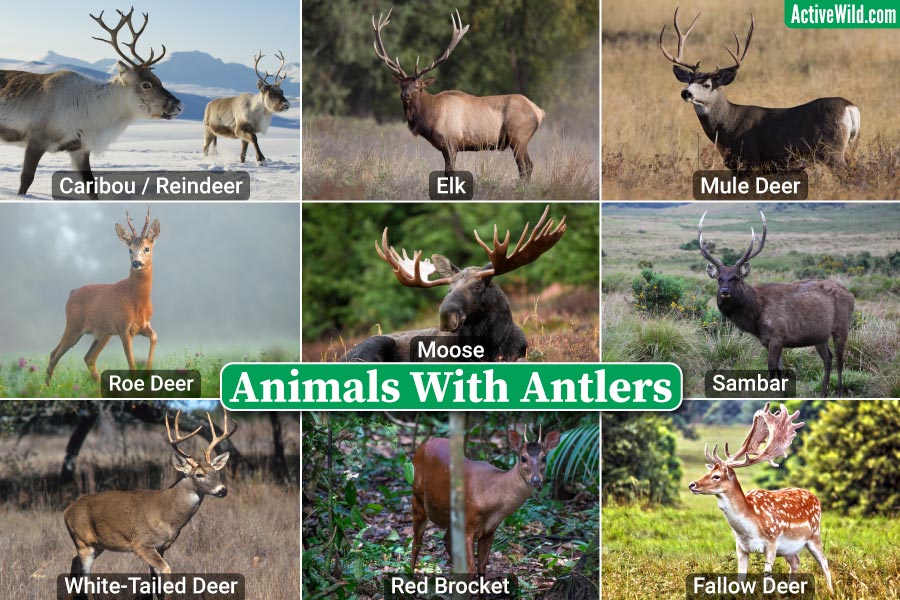Examples of animals with antlers include the caribou / reindeer (the only species in which both males and females have antlers), elk, fallow deer, moose (the species with the largest antlers), mule deer, white-tailed deer, sambar, chital and taruca.
On this page, you’ll find pictures and interesting facts on these and other animals with antlers. You’ll also find out: what antlers are for, what they’re made of, and how antlers are different to horns.
What Type Of Animals Have Antlers?
The only animals with antlers are deer. Deer are hooved mammals belonging to the family Cervidae. Currently, 51 species of deer are recognized. (source)
Antlers, which are grown and shed annually, should not be confused with horns, which remain permanently attached to an animal’s head throughout its lifetime.
You can find out more about the difference between antlers and horns further down the page.
You can see a list of animals with horns on this page: Animals with Horns.
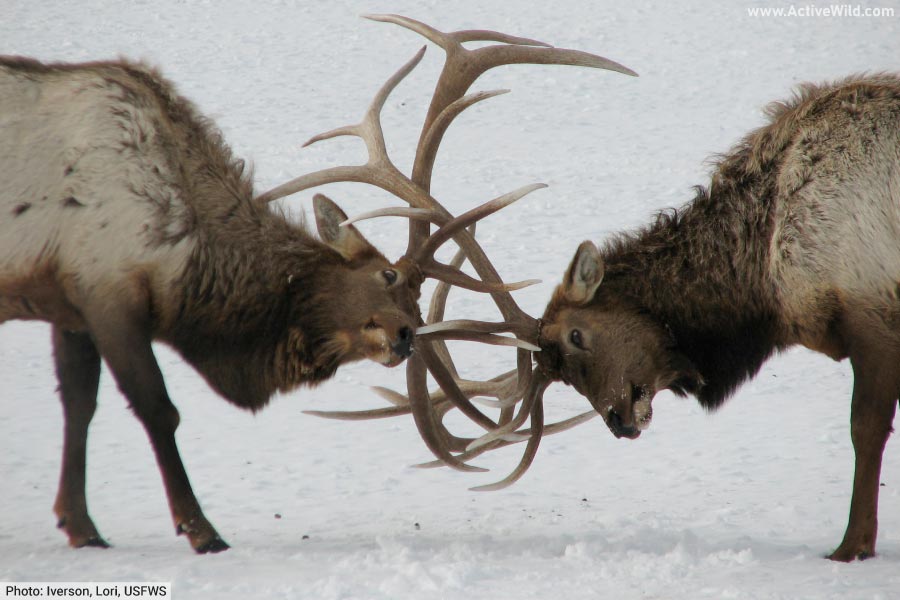
Page Index
Examples Of Animals With Antlers
- Caribou
- Chital / Spotted Deer / Axis Deer
- Elk
- Fallow Deer / European Fallow Deer
- Moose
- Mule Deer
- Red Brocket
- Red Deer
- Roe Deer
- Sambar
- Sika Deer
- Northern Pudu
- Taruca
- White-Tailed Deer
What Type Of Animals Have Antlers?
Examples Of Animals With Antlers
Caribou
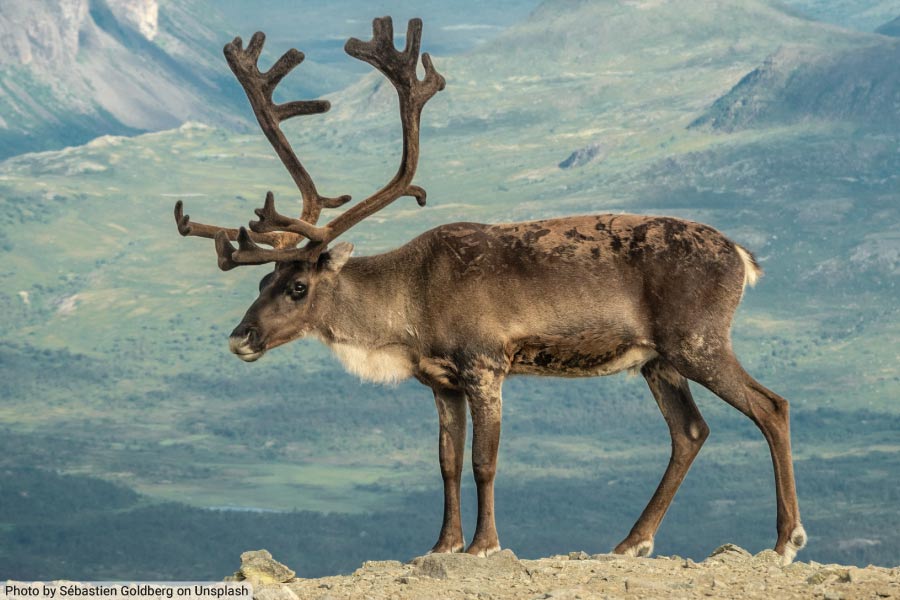
- Scientific name: Rangifer tarandus
- Where found: North America, Europe, Asia (Siberia)
- Conservation status: Vulnerable
- Antler size: width: 100 cm / 3.28 ft.; length: 135 cm / 4.43 ft.
Caribou, also known as reindeer, are large deer found in Arctic and sub-Arctic regions in the northern hemisphere.
There are several caribou subspecies; those found in the wild in North America are known as caribou; those in Europe and northern Asia are known as reindeer.
A male caribou’s antlers can reach lengths of up to 1.35 m / 4.43 ft. They’re the second-largest antlers of any animal (only those of the moose are larger), and the largest of any animal in relation to body size.
The caribou is the only deer species in which females have antlers (the female caribou’s antlers are considerably smaller than those of the male).
Caribou in Canada undertake the longest migration of any land animal. In a single year they can travel as far as 3,000 miles / 5,000 km.
Reindeer have been closely associated with Christmas since the early nineteenth century. Santa Claus’s sleigh is pulled by a team of nine reindeer, led by Rudolph, the “red-nosed reindeer”.
You can find out more about caribou / reindeer on this page: Caribou Facts
You can see more Arctic animals on this page: Arctic Animals
You can see more Christmas animals on this page: Christmas Animals From All Around The World
Chital / Spotted Deer / Axis Deer
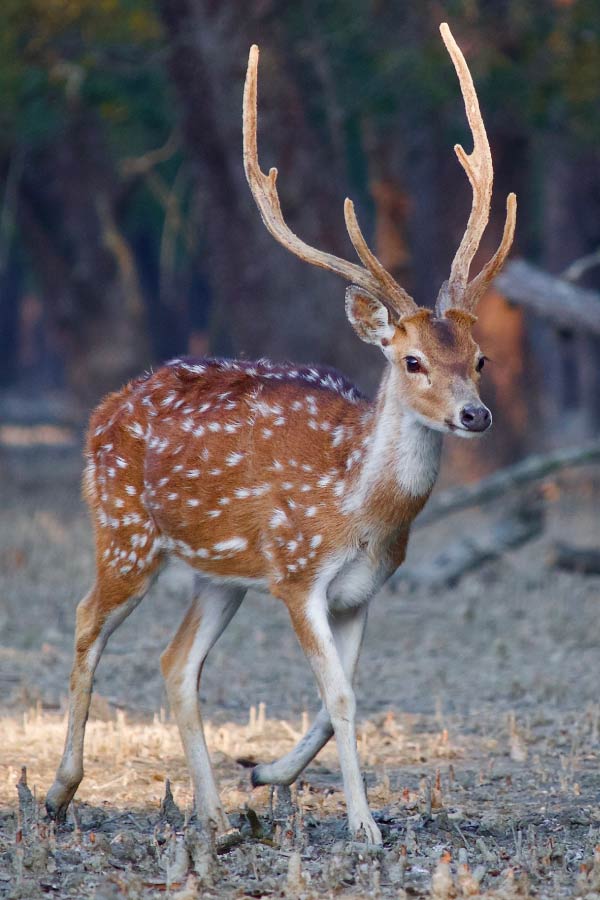
- Scientific name: Axis axis
- Where found: Asia, introduced to Australia and parts of the United States
- Conservation status: Least Concern
- Antler length: 100 cm / 3.28 ft.
The chital, also known as the spotted deer or axis deer, is a medium-sized deer found on the Indian Subcontinent. It inhabits a variety of habitats, ranging from thick forests to deserts.
The species was introduced to Australia, where it is one of the six deer species (all non-native) now found wild on the continent. Other introduced populations can be found in Hawaii and in several locations in the mainland United States.
The species has a dark, golden-red coat marked with numerous small white spots. A dark line runs the length of the animal’s back. Each antler has three tines.
The chital’s numerous predators include fearsome mammals such as tigers, leopards, wolves and dholes.
In Hawaii, the chital has no natural predators. As a result, the species’ population is growing unchecked, and the deer is causing significant damage to the state’s crops.
You can see more Asian animals on this page: Asian Animals
Elk
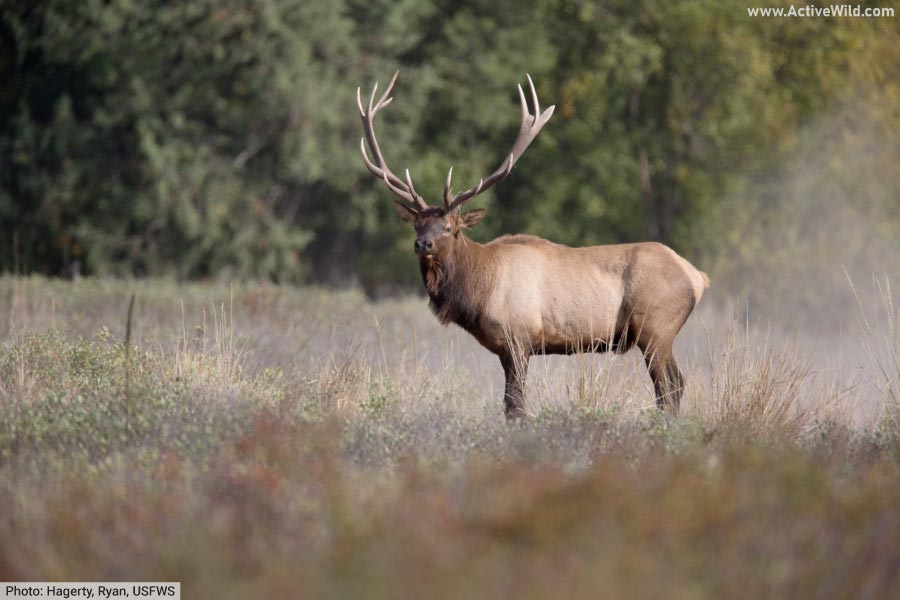
- Scientific name: Cervus canadensis
- Where found: North America, Asia
- Conservation status: Least Concern
- Antler width: 1.22 m / 4 ft.
The elk is the second-largest member of the deer family, Cervidae (the family to which all animals with antlers belong); only the moose is larger.
The elk is found in forests, shrublands and grasslands in North America and Asia. It often inhabits mountainous regions, moving to lower altitudes during the winter.
During the rut, the male makes loud, high-pitched “bugle” calls.
Until recently, the elk was thought to be a subspecies of red deer, a large European species. The two species are able to produce hybrid offspring.
You can find out more about the elk on this page: Elk Facts
Fallow Deer / European Fallow Deer
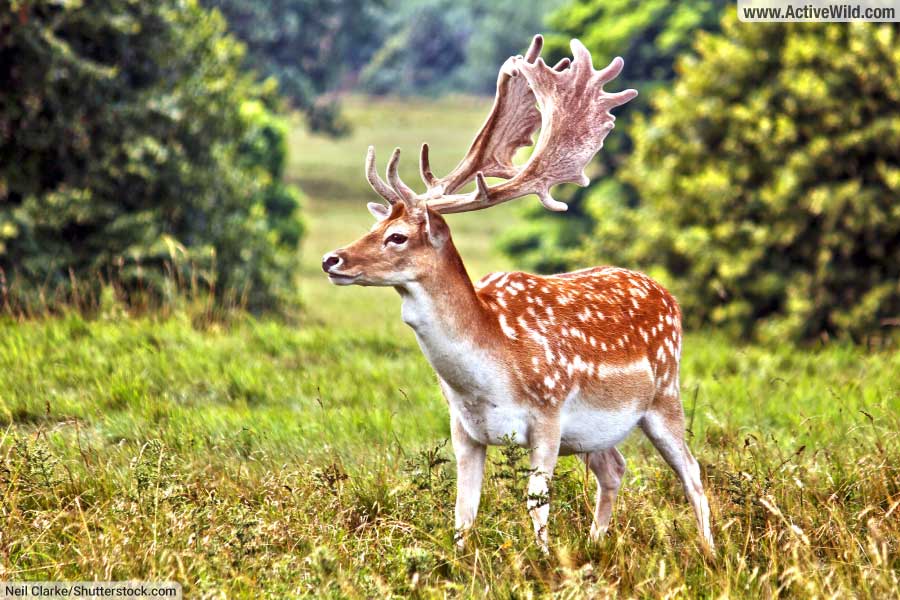
- Scientific name: Dama dama
- Where found: Europe, Introduced to North America And Australia
- Conservation status: Least Concern
- Antler length: 70 cm / 2.3 ft.
Originally native to southeast Europe, the fallow deer, or European fallow deer, has been introduced into much of the rest of Europe, including Great Britain, as well as to Australia and parts of the United States.
The fallow deer typically has a sandy-brown coat with numerous white spots, although coat color does vary significantly between individuals, and several color variations are known, including all white and all black specimens.
Unlike those of most other deer, the antlers of the fallow deer are palmate (shaped like an open hand).
Some zoologists consider the closely-related Persian fallow deer to be a subspecies of fallow deer, rather than a separate species.
Moose
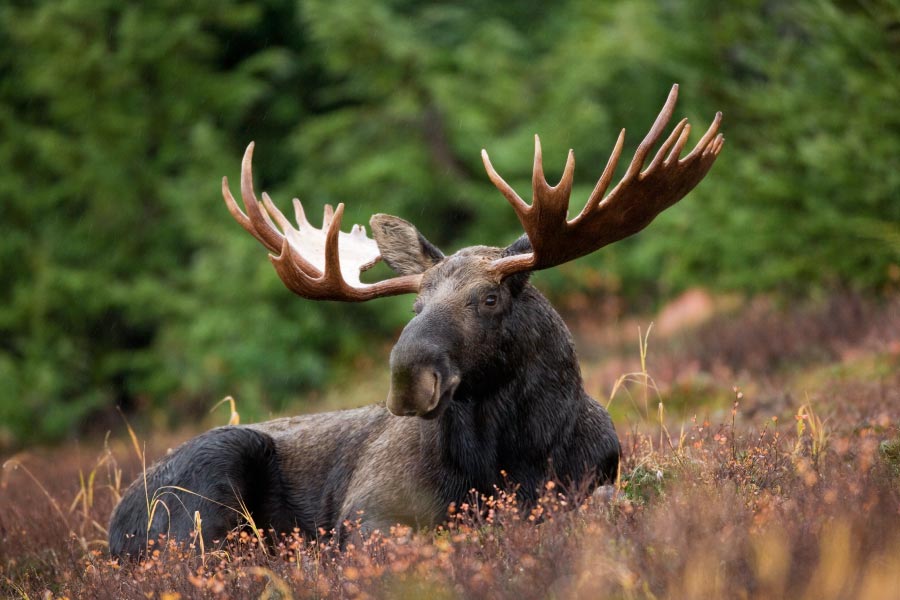
- Scientific name: Alces alces
- Where found: North America, Europe, Asia
- Conservation status: Least Concern
- Antler width: 2 m / 6.56 ft
The moose is the largest living member of the deer family. A big male can stand over 2 m / 6.56 ft tall at the shoulder, and may weigh up to 700 kg / 1543.24 lb.
The moose has the largest antlers of any living animal. Unusually, the moose’s antlers are “palmate” (shaped like an open hand)
It’s not just the moose’s size and palmate antlers that makes it one of the world’s most distinctive large mammals; the species can also be recognized by its long face, prominent lips, and the fleshy flap of skin – known as a “bell”, or “dewlap”, that hangs from the chin of both males and females. (The exact function of the dewlap is unknown.)
Moose are large, powerful animals and can be dangerous. Males become particularly aggressive during the mating season. Females with calves may also attack if they feel threatened.
You can find out more about the moose on this page: Moose Facts
Mule Deer
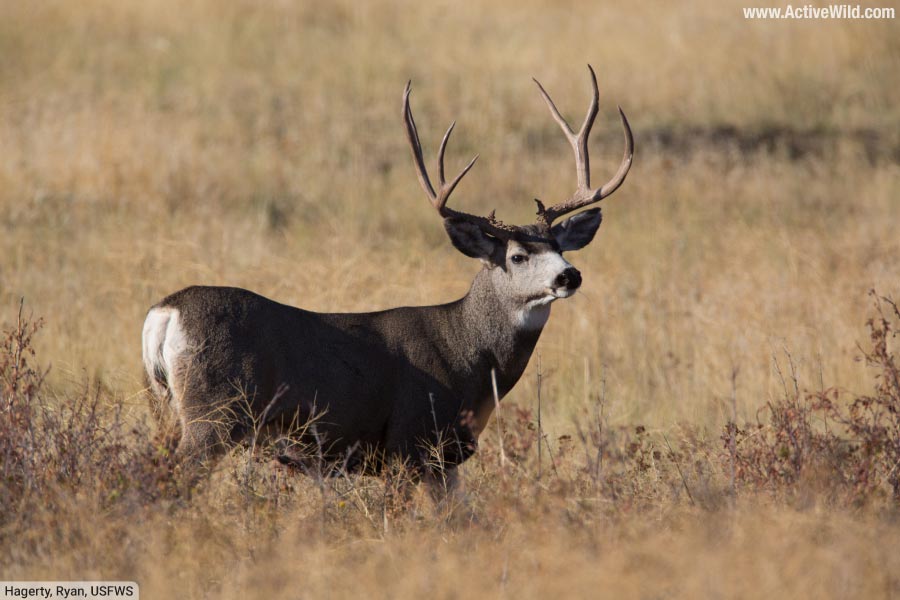
- Scientific name: Odocoileus hemionus
- Where found: North America
- Conservation status: Least Concern
The mule deer is a deer native to North America that is found in the central and western United States, southwest Canada and north Mexico. Its range overlaps with that of the closely-related white-tailed deer (another native species), which is found across a wider area of North America.
The mule deer is named for its large, “mule-like” ears. It ranges from gray to reddish-brown in color.
Subspecies (types) of mule deer include the Rocky Mountain mule deer, California mule deer and Columbian black-tailed deer.
The tails of some mule deer subspecies (e.g., the Columbian black-tailed deer) are black, and these subspecies are known as “black-tailed deer”. Only the tips of the tails of the other subspecies are black.
The antlers of the mule branch into pairs of spikes, whereas the tines on the antlers of the white-tailed deer grow from a single main beam.
You can see more North American animals on this page: North American Animals
Red Brocket
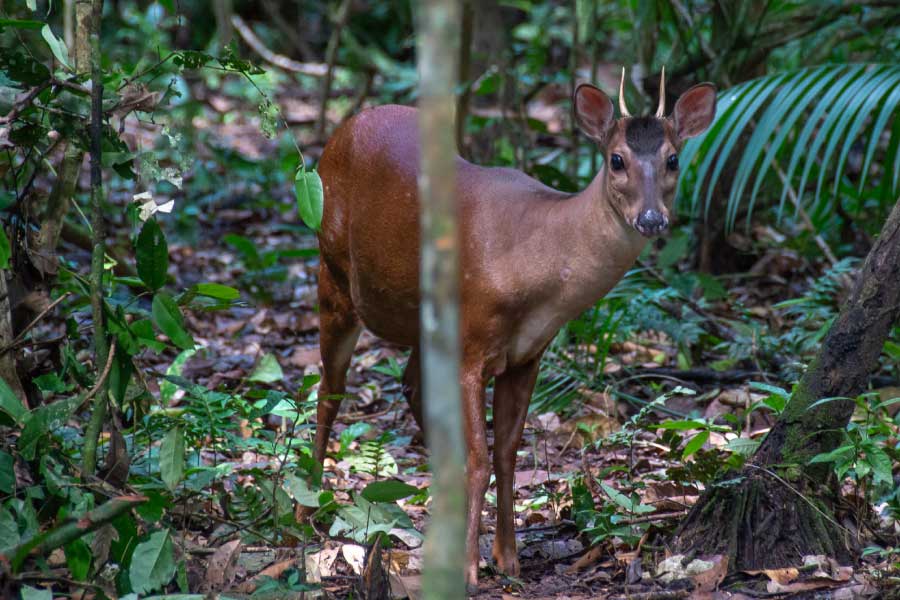
- Scientific name: Mazama americana
- Where found: South America
- Conservation status: Data Deficient
The red brocket is a medium-small deer found in forests in northern South America, including the Amazon rainforest.
The species is one of nine currently-recognized species of brocket deer, which together make up the genus Mazama. (source)
Standing at up to 80 cm / at the shoulder, the red brocket is the largest of the brocket deer. Its antlers are small and spike-shaped.
You can see more South American animals on this page: South American Animals
Red Deer
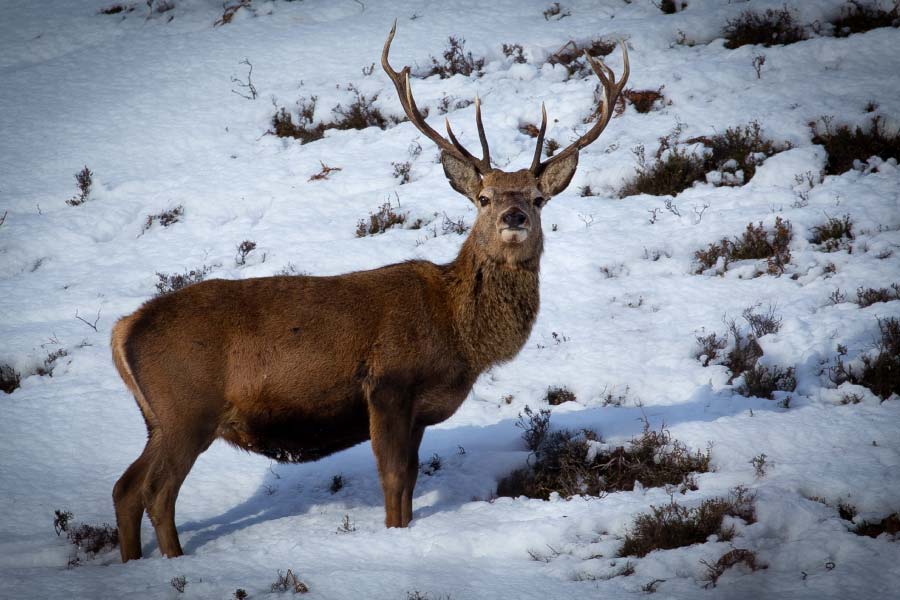
- Scientific name: Cervus elaphus
- Where found: Europe, parts of Asia, Northwest Africa
- Conservation status: Least Concern
The red deer is the world’s fourth-largest species of deer (behind the moose, elk and sambar). The species stands up to 1.3 m / 4.27 at the shoulder, and is the largest land mammal of the British Isles.
The color of the red deer ranges from red-brown to grayish-brown, depending on the time of year and subspecies.
The Barbary stag, a red deer subspecies, is the only deer native to Africa. It inhabits dense forests in the north of the continent. The subspecies is also known as the Atlas deer, or African elk.
Roe Deer

- Scientific name: Capreolus capreolus
- Where found: Europe, Middle East
- Conservation status: Least Concern
The roe deer is a small deer native to Europe and parts of the Middle East. It has a red / reddish-gray coat, a white rump and lacks a tail.
This adaptable species is able to live in a wide range of habitats. Its population numbers around 15 million adult individuals and is thought to be rising.
The antlers of the roe deer are relatively small, growing to a maximum length of 25 cm, and typically having three points.
Unlike other deer, a roe deer’s antlers begin growing almost immediately after the previous pair are shed.
Sambar
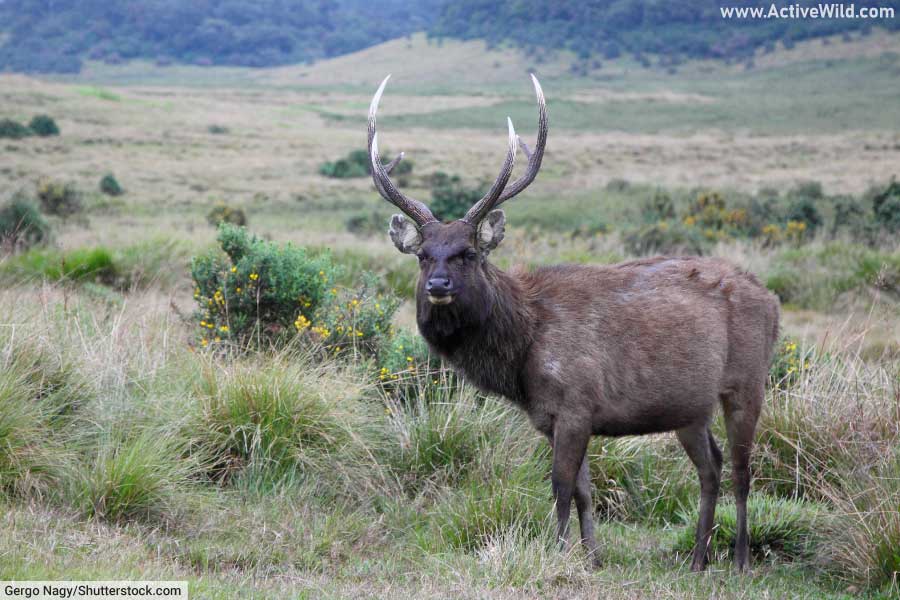
- Scientific name: Rusa unicolor
- Where found: Asia, Australia (introduced), North America (introduced)
- Conservation status: Vulnerable
The sambar is a large, dark brown deer found in Asia. It is present throughout much of the Indian Subcontinent and Southeast Asia, including islands such as Sumatra and Borneo. The species has also been introduced into Australia and parts of Texas, California and Florida.
The sambar is the world’s third largest species of deer – only the moose and elk are larger. It stands up to 1.6 m / 5.25 ft. at the shoulder.
The antlers of the sambar reach a length of up to 1.1 m / 3.61 ft, and have three tines, or points.
The sambar is nocturnal and / or crepuscular (active at dusk and dawn). One of the species’ main predators in Asia is the tiger. It is said that the big cat is able to imitate the sambar’s call.
You can see more Asian animals on this page: Asian Animals
Sika Deer
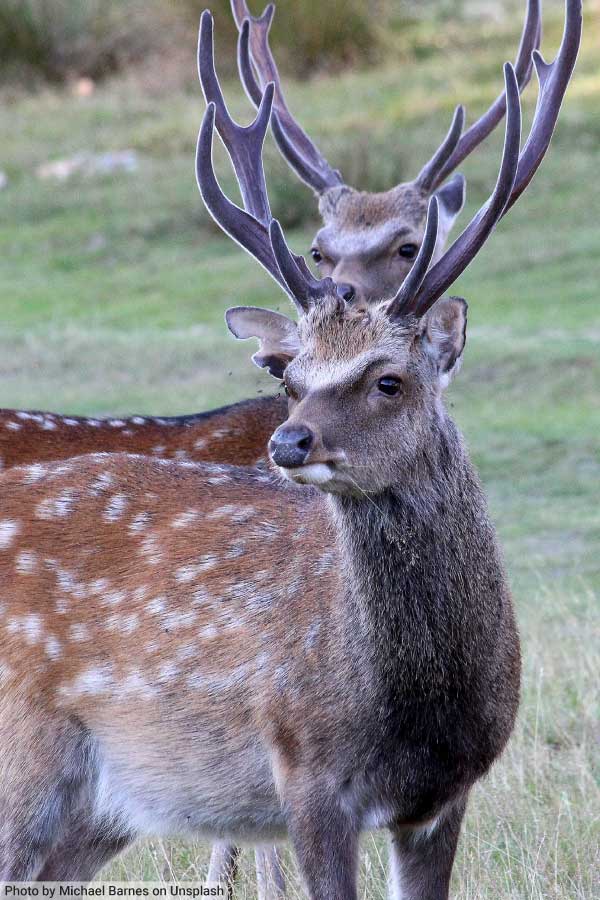
- Scientific name: Cervus nippon
- Where found: Asia, North America (introduced)
- Conservation status: Least Concern
The sika deer is a small species native to Asia and introduced into parts of Texas and Maryland. It typically inhabits dense forest and woodland, but will also be seen foraging in grassy clearings.
The species can be identified by its small size, wedge-shaped head, and dark brown coat with white spots. Males have antlers with three or four points that branch off of the main beam.
You can see more Asian animals on this page: Asian Animals
Northern Pudu
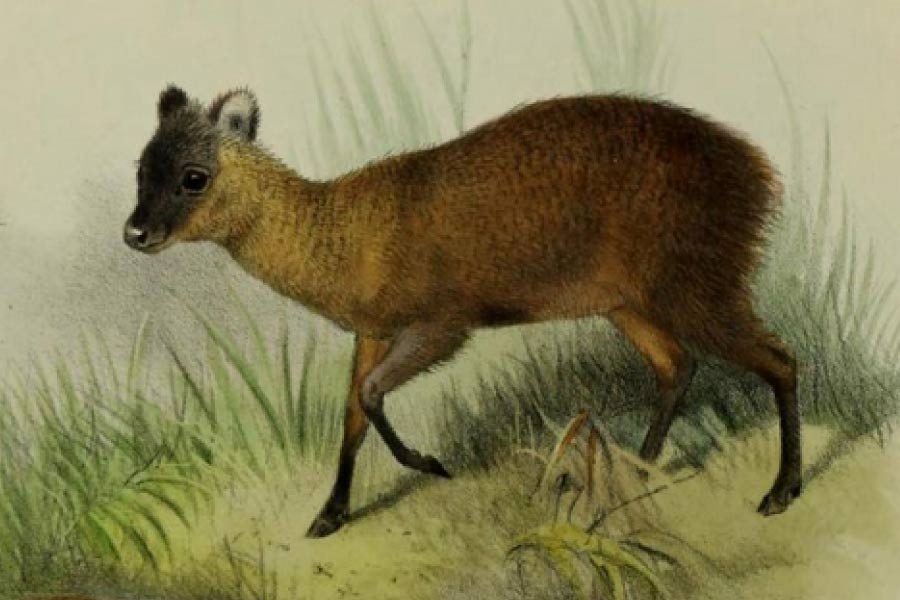
- Scientific name: Pudu mephistophiles
- Where found: South America
- Conservation status: Data Deficient
The northern pudu is a South American species of deer found in high-altitude Andean forests, shrublands and grasslands in Colombia, Ecuador and Peru.
The species, which has a maximum shoulder height of 35 cm / 13.78 in., is the world’s smallest species of deer. It is slightly smaller than the closely-related southern pudu, which is found in forests and shrublands in Argentina and Chile.
The antlers of the northern pudu are short and spike-like, curving slightly backwards and reaching a maximum length of 6 cm /2.4 in.
You can see more South American animals on this page: South American Animals
Taruca
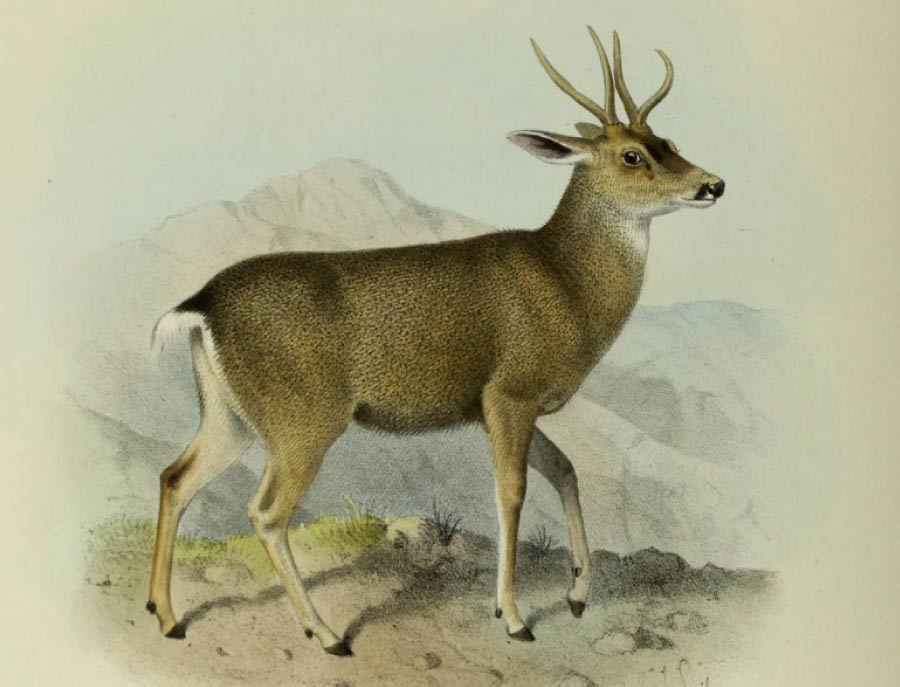
- Scientific name: Hippocamelus antisensis
- Where found: South America
- Conservation status: Vulnerable
The taruca is a medium-sized deer species found in the Andes in Argentina, Bolivia, Chile and Peru. It inhabits rocky areas, mountainous shrublands and grasslands, often above the treeline.
The taruca’s antlers consist of two tines, branching from the base. The larger hind tine reaches a length of up to 30 cm / 12 in.
The taruca’s closest relative is the South Andean deer, an endangered species found in the mountains of Argentina and Chile.
You can see more South American animals on this page: South American Animals
White-Tailed Deer
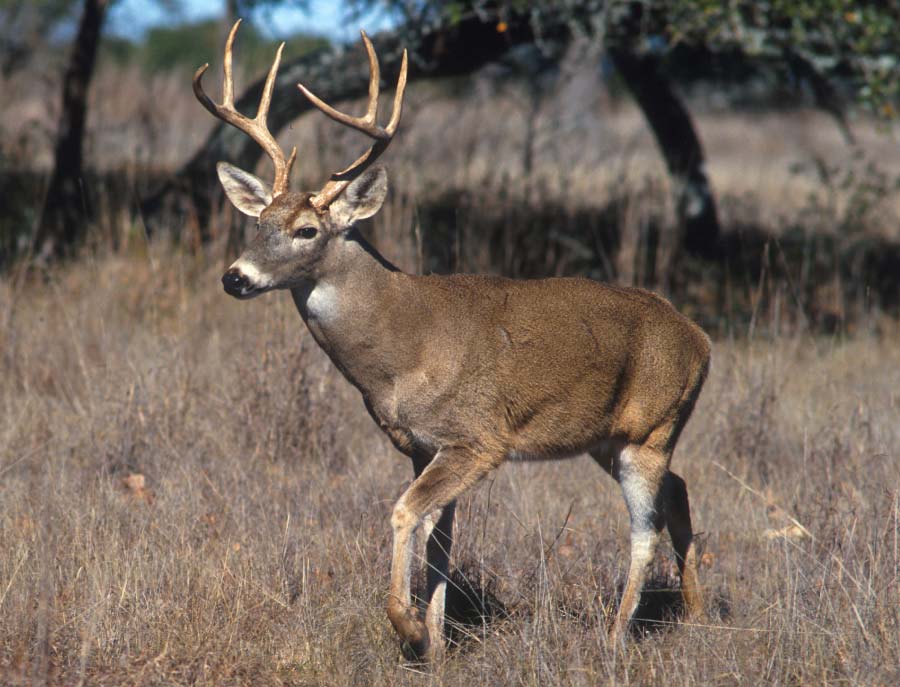
- Scientific name: Odocoileus virginianus
- Where found: North America, South America
- Conservation status: Least Concern
The white-tailed deer is closely related to the mule deer, another medium-sized deer species native to North America. Unlike that of its cousin, the range of the white-tailed deer extends southwards through Central America and into northern South America.
Smaller ears, a long and whiter tail, and antlers with spikes growing from a main length rather than branched pairs are characteristics that differentiate the white-tailed deer from the mule deer.
The white-tailed deer is found throughout much of the United States in wide range of habitats, including forest, grassland, coastal and desert.
You can see more North American animals on this page: North American Animals
Facts On Animals With Antlers
The only deer without antlers is the water deer, Hydropotes inermis. Instead of antlers, the water deer has small, downward-pointing tusks that resemble fangs.
In all but one deer species, antlers are only found on males; the only species in which both males and females have antlers is the caribou, also known as the reindeer.
The moose is both the largest animal with antlers and the animal with the largest antlers. The smallest animal with antlers is the Northern Pudu, a tiny deer found in the Andes of South America.
Deer are found on every continent except Antarctica, but are not native to Australia, where they were introduced by humans.
Only one species of deer is found in Africa: the Barbary stag, which is a subspecies of red deer.
Deer have been hunted by humans for thousands of years. As a result, many species of deer have been introduced to countries and continents outside of their native ranges.
Antlers Vs Horns
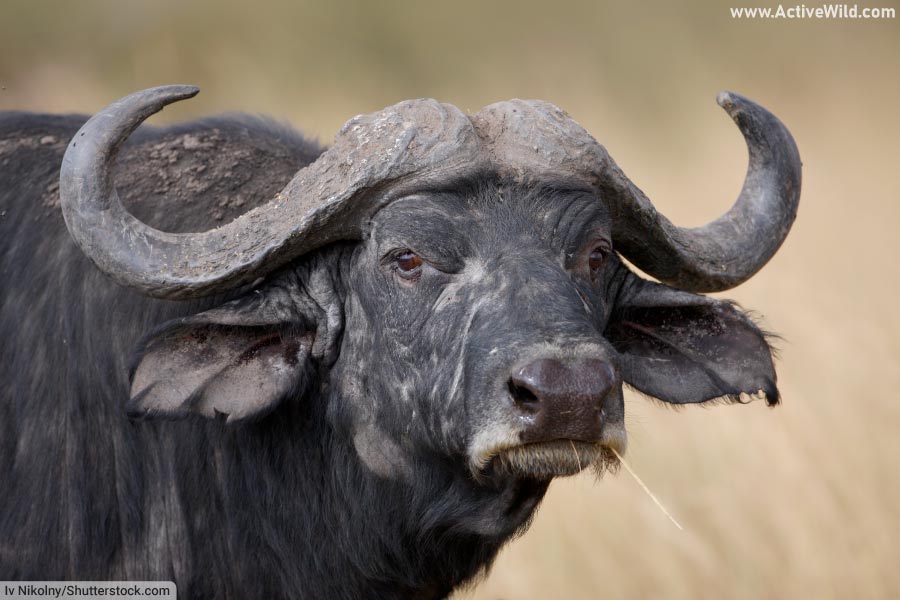
Unlike horns, which grow throughout an animal’s lifetime and are never shed, antlers grow and are shed annually.
Antlers are made of bone, and are extensions of an animal’s skull. During their growth period, antlers can grow up to one inch per day, making them the fastest-growing animal bones.
Unlike antlers, horns have a two-part structure: a central core of bone, which is surrounded by a sheath of keratin.
Antlers are found only on members of the deer family, Cervidae. Horns are found on members of two animal families: Bovidae and Antilocapridae.
(Bovidae, also known as the cattle family, is home to animals such as domestic cattle, bison, antelopes, sheep and goats. The family Antilocapridae contains just one species: the pronghorn, which, although not a true antelope, is known as the “American antelope”.)
Antler Facts
Antlers may have evolved as an alternative to tusks. The ancestors of deer were tusked animals, and today, the only deer not to have antlers (the water deer) has tusks instead. Only one species of deer, the muntjac, has both antlers and tusks.
The fact that antlers are only found on male deer suggests that their main use is fighting; during the rut, male deer fight one another for dominance and mating rights over females. The size of a deer’s antlers are thought to correlate to mating success.
Another use of antlers is self-defense against predators. Studies have found that males without antlers are more likely to be predated by wolves than those whose antlers have not yet been shed.
“Shed hunting”, a pastime that involves collecting the shed antlers of deer, is a popular activity in North America.
Discover More With Active Wild
You can see more horned animals on this page: Animals With Horns
You can find out more about mammals on this page: Mammals – The Ultimate Guide
Discover different types of mammals on this page: Types of Mammals
Become an expert on the entire animal kingdom: Animals - The Ultimate Guide

